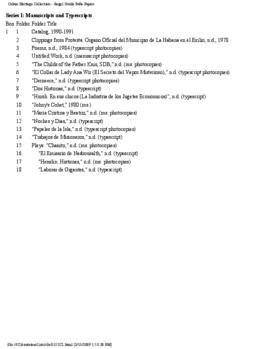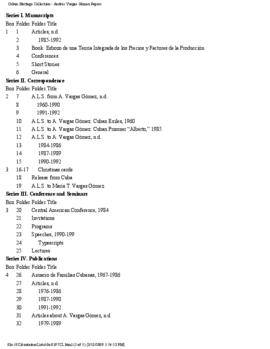The collection contains documents, photographs, printed PowerPoints and a USB with digital information related to architect Alicia Pujals Mederos.
Biography:
Alicia Romelia María Pujals y Mederos was born in La Habana, Cuba, on December 12, 1921. Her parents were Romelia Mederos y Cabañas and Francisco Pujals y Claret. She was the couple's third of four children: Francisco, Elena, Alicia, and José. Her older brother, Francisco, was an engineer (as was her father); her older sister, Elena, was also an architect; and her younger brother, José, was an agricultural engineer. Alicia enjoyed a charmed youth, surrounded by family and friends, many with whom she remained close throughout her life. She grew up in an environment grounded in strong family, moral, and ethical values, as well as a deep appreciation of nature and the Arts, particularly anything related to "extraordinary" architectural and engineering designs. While growing up in Cuba, she traveled widely with her family throughout Cuba and also visited a number of places in Europe, Latin America, Canada, and the U.S.A. This travel exposed her to different cultures as well as art and architecture throughout the ages and around the world.
Her formal education started at El Colegio Sepúlveda and continued at El Instituto de Segunda Enseñanza de La Habana. She then went on to study Architecture at La Universidad de La Habana, where she met her future husband, Raúl L. Mora y Suarez Galbán. They married on December 23, 1945 and had three children (Alicia Cristina, María Elena, and Raúl Francisco). Alicia graduated from the School of Engineering and Architecture at La Universidad de La Habana, earning the title of Architect on July 15, 1946. She initiated her work as a Professional Architect at Pujals y Cia., her family's firm, and her work received acclaim with immediacy. Her achievements as an architect included industry awards and recognition in multiple professional, educational, and popular publications, including Álbum de Cuba and Vanidades. Her work was featured in exhibits at El Lyceum, Colegio de Arquitectos, and Palacio de Bellas Artes in Cuba; the Architectural League of New York; and The Florida Association of Architects Convention (held in Palm Beach, FL in 1955).Alicia's first home was at "Malecón 40." She lived there until her parents moved their family to a new home at "Quinta Avenida y 24, Miramar." Her final home in Cuba was at the house that she and her husband (Structural Engineer Raúl L. Mora y Suarez Galbán) designed and built at "Calle 24 #505 5ay 7a Ave., Miramar." This house was the "crowning joy" of their professional experience. Florencia Peñate Díaz writes that these works are “characterized by their rationalist codes, the use of reinforced concrete, glass, levels roofs with elements of environmental adequacy such as wide eaves and transparent shutters” (76). Unfortunately, they were only able to enjoy this home for a few years before the family deemed it necessary to leave Cuba. However, in future years they were able to collaborate in the design and construction of two other homes for themselves - the first in Dade City (Pasco County, FL) in 1980, and the second, an addition to the home they had designed for their daughter Maria Elena and her family in Dade City in 1970, which was completed in 2007.
In July 1960, Alicia and Raúl emigrated to the U.S.A. with their three children and two nephews. They also opened their home to Alicia’s brother and his wife’s children, Victor J., Gloria I., and Beatríz M. right through their college years, as José was a political prisoner in Cuba until 1988. Upon realizing that their stay in the United States would not be a short one, Alicia and Raúl followed the established procedures to change their immigration status from "Tourist" to "Resident," and eventually became Naturalized American Citizens. In addition, they applied for "Registration" as a "Professional Architect" and "Professional Engineer," so they could practice their professions in the United States. Raúl succeeded in this pursuit, but Alicia as well as her sister Elena (who had already become a renowned Architect in Cuba and abroad, as well as an esteemed Professor of Architecture at La Universidad de La Habana) were unfathomably denied their requests by the Florida State Board of Architecture. The rejection from the State Board of Architecture meant that both Alicia and Elena would have to submit to a series of oral and written exams before they could be considered for Registration status. This also meant that they would not be able to practice their beloved profession in Florida.
Since both Alicia and her sister Elena were actively engaged with other professionals in similar situations, they were cognizant of the fact that a number of male Cuban architects (some of them former students of her sister Elena, at La Universidad de La Habana) had
been granted the "Registration" they sought, without additional exam requirements. As a result, both Alicia and Elena were encouraged to appeal the State Board's ruling, but their appeals were denied. On the basis of previous work-based experiences, they interpreted this "final" ruling by the Board as a personal affront, perhaps influenced by the fact that they were women in a male-dominated industry and were thus unwelcome colleagues. Judging by feminist architectural scholarship such as that by Díaz, who has written about female architects in Cuba, focusing on the Pujals sisters specifically, the women were correct in their interpretations.1 As a result, they decided to take a stand in protest of what they believed to be a discriminatory and unjust decision by refusing to take the exams. They realized and accepted the fact that taking such a stand, would limit their opportunities to practice architecture.
In spite of this major setback, however, their determination and love or architecture kept them active in the field. Elena turned to the field of Education, and Alicia found satisfying architectural work with Miller Florida Homes, Inc. - prominent developer in the State of Florida - and would maintain this working relationship for nearly 50 years. Alicia’s innovative designs gave the Millers an edge in the highly competitive South Florida residential construction market and caused their sales to increase beyond expectations. Over the years, Alicia's influence with Miller Homes, Inc., in Florida expanded to developments in Broward County (Lakeview Estates in Plantation), Palm Beach County, and Hillsborough County (Ruskin). Near the end of her career (at age 70), she received the First-Place award for the design of Model 1003 Trendsetter for Miller's Florida Homes, Inc.at the Ruskin, FL, Parade of Homes. This late award came after numerous others during the course of her career; most notably she won First-Place in a low budget model house competition for the Corporación Nacional de Asistencia Pública, which was built in 1948 in Cuba when she was 27 years old.
On August 11, 2008, surrounded by her husband, children, grandchildren, and extended family, Alicia passed away peacefully.
Notes
- Díaz writes that during the modernization of Cuban architecture, whereby new designs began to distinguish themselves from the colonial, female architects were as much part of the movement as men. Despite the fact that in 1906 the first woman matriculated in architecture on island, the University of Havana did not start admitting female students in architecture until 1922/23. By 1952, however, there were substantially more female matriculates which was a reflection of wider breakthroughs in women’s rights, such as divorce rights, the right to work, and the right to vote. Regardless of how much women were actually involved in the architectural modernization of Cuba, magazines and publications at the time framed women’s contributions as ancillary to that of men, which is a trend that has largely continued in the historical narrative of Cuban architectural development. Therefore, Diaz believes that the importance of her research lies in identifying modern architectural works designed by women and, with this in mind, legitimizing under-recognized labor, barely reflected in studies regarding architecture. See: Florencia Peñate Díaz, “La obra de las arquitectas cubanas de la República entre los años 40 y fines de los 50 del siglo XX / The work of female Cuban architects of the Republic between the 1940s and the late 50s of the 20th century.” Arquitectura y Urbanismo, vol. 33, no. 1, 2012, pp. 70-82.
Works Cited
Díaz, Florencia Peñate. “Significado de la obra de las arquitectas cubanas Elena y Alicia Pujals Mederos / The significance of the work of Cuban architects Elena and Alicia Pujals Mederos.” Arquitectura y Urbanismo, vol. 37, no. 1, 2016, pp. 26-36.





